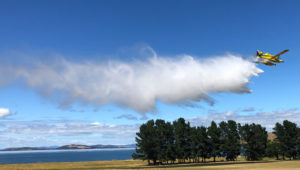Who is responsible for aerial firefighting in Australia?
The responsibility for suppression of bushfires rests with the Governments of each of the Australian States and Territories. Where it is safe, efficient and cost effective to do so, most States and Territories utilise aircraft to support their fire suppression and other fire management activities.
Most firefighting aircraft are leased from appropriately experienced and qualified Australian commercial aircraft providers. The State and Territory agencies involved in firefighting and land management recognise that improved performance, cost savings and other synergies may be obtained through cooperation and sharing of resources and support systems between States and Territories. This is especially so for expensive, highly specialised resources such as firefighting aircraft. The NAFC arrangements allow for the procurement of these resources and the sharing and cooperation of these resources between agencies across the country.
Each State and Territory Government has established one or more agencies that are responsible for bushfire prevention and suppression. For more information on the individual agencies involved in fire in Australia, visit the AFAC website: afac.com.au.
What are the aircraft used for in fighting bushfires?
Aircraft undertake a wide range of valuable support tasks, including:
- Firebombing – the dropping of water, or foam or fire retardant slurries on, or in front of the fire, to reduce or halt the spread of the fire;
- Rapid delivery of firefighters to remote areas by rappelling or winching;
- Fire detection, reconnaissance and mapping (including with highly sophisticated infra-red sensors;
- Command, communications and control;
- Transportation of firefighters and equipment; and
- Aerial ignition – dropping of approved incendiary devices to ignite backburns or planned fuel reduction burns.
What types of aircraft are used?
A wide range of fixed-wing and rotary-wing aircraft are used to support fire operations. Aircraft are selected for individual tasks based on their suitability for the task and their cost effectiveness.
Larger helicopters are most often used for firebombing and crew transportation, whilst smaller helicopters are more often used for command and control, mapping and aerial ignition.
Fixed-wing aircraft that are used for firebombing tend to be of the larger agricultural-style, specially modified for firebombing. These aircraft are sometimes referred to as SEATs (Single-Engined Air Tankers). This type of aircraft particularly suits the conditions most often encountered in Australia where there are relatively few long paved runways, but plenty of agricultural airstrips. Larger fixed-wing aircraft have been used where appropriate and cost-effective. Light fixed-wing aircraft are also regularly used for fire detection, reconnaissance, command and control.
